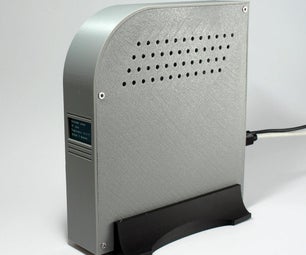Introduction: IOT123 - SOLAR TRACKER - TILT/PAN, PANEL FRAME, LDR MOUNTS RIG
Most of the DIY designs for dual axis solar trackers "out there" are based on the 9G Micro Servo which really are under-rated to push around a couple of Solar Cells, the micro-controller, the battery and the housing. You can design around having the battery and micro-controller separate, but this way you have the option of the Solar Tracker, battery, micro-controller(s) and the sensors/actors being incorporated into a single assembly.
This Assembly is specifically built for the MG995/MG996R servos and 2 off 69mm x 110mm solar cells. The Panel Frame is modular and can be adapted for other size cells.
A separate instructable/thing will be available for the battery/micro-controller, though this assembly is seen as independent and will fit in with your own solution.
These servos draw more current than the 9G; a sleep and day/night schedule should be employed with your tracking solution.
Features
- Modular design - easy to customize for different size cells.
- Sun proximity sensor array (LDRs) built in to panel frame
- Strong servo movement
- Hidden base fixture holes - fasten from underside.
- Zip-tie friendly circuit cavity for battery/electronics
Expected Variations
- Size and number of solar cells
- Type and number of batteries
- The size of the circuit cavity
- The geometry of the tilt/pan reach
HISTORY
- Dec. 15, 2017
- Initial Submit
- Jan 29, 2018
- Height adjustment
Step 1: Materials and Tools
There is now a full Bill of Materials and Sources list.
- 3D printed parts (see next step)
- 2 off 69mm x 110mm solar cells
- 4 off LDRs (Light-Dependent Resistors)
- 2 off MG995/MG996R servos
- 3 off DuPont Cable Ribbon Jumper Wire Female to Female 40cm (cut in half)
- ~20 off 4G x 6mm stainless self-tapping pan head screws
- ~10 off 4G x 9mm stainless self-tapping pan head screws
- Cable ties ~2mm wide
- Hot glue and hot glue gun
- Silicone sealant
- 2 off pairs of waterproof JST connectors
- Solder and iron
Solder Flux
Step 2: The Parts to Print
The names of the parts relate to the STL filenames on Thingiverse.
- 2 off SOLAR PANEL side 138mm
- 2 off SOLAR PANEL side 110mm
- 4 off SOLAR PANEL corner
- 1 off SOLAR PANEL stay 110mm
- 1 off SOLAR PANEL bottom cover 138x110mm
- 1 off MG995 TILT PAN base block
- 1 off MG995 TILT PAN base lid
- 1 off MG995 TILT PAN corner
- 1 off MG995 TILT PAN vert arm
- 1 off MG995 TILT PAN vert bracket
Step 3: Assembling the Panel Housing
- Affix 2 off SOLAR PANEL corner to SOLAR PANEL side 138mm with 4G x 6mm screws.
- Repeat point #1.
- Affix SOLAR PANEL side 110mm between the assembled pieces in point #1 & point #2 with 4G x 6mm screws.
- Repeat point #3.
- Affix SOLAR PANEL stay 110mm between the 2 off SOLAR PANEL side 138mm on the top surface with 4G x 6mm screws.
Affix SOLAR PANEL bottom cover 138x110mm between the 2 off SOLAR PANEL side 138mm on the bottom surface with 4G x 6mm screws.
Step 4: Adding the LDRs and Solar Cells
- Thread the leads from an LDR into the two small holes in a SOLAR PANEL corner from the outside.
- Bend the LDR so it is pointing upwards and prefit it so that is sits on the small ledge.
- Pull the LDR out and up slightly, put a dob of hot glue making sure it seals the holes.
- Push the LDR into its final position while the glue cools.
- Repeat points #1 to #4 for the other corners.
- On the inside of a corner, trim all but 7mm of LDR leads sticking out and tin.
- Solder a 20cm female dupont lead (1/2 a 40cm female to female lead) to the LDR leads.
- Add a dob of hot glue as insulation and strain relief.
- Repeat points #6 to #8 for the other corners.
- Pre-fit 2 off Solar Cells to top of panel frame.
- Turn over onto firm flat surface, ensuring panels stay in top groove.
- Apply bead of Silicone sealant to edge of cells exposed bonding to 3D printed parts.
- Clear the edges of the centre stay of silicone, where the MG995 TILT PAN vert bracket will be affixed later.
- Allow to dry.
- Apply flux agent to the output pads on the solar cells,
- Tin the output pads
- Solder female JST connectors to pads on Solar Cells.
- Route and affix cables to SOLAR PANEL bottom cover 138x110mm with cable ties.
Step 5: Assembling the Lower Servo Base
- Insert Rubber Grommets into Servo mount holes.
- Insert Brass Bushes into Rubber Grommets from underside (flanges pointing down).
- Insert supplied screws into Brass Bushes from underside and affix to MG995 TILT PAN base lid.
- Affix MG995 TILT PAN base lid with mounted servo onto MG995 TILT PAN base block from underside with 4 off 4G x 6mm screws.
- Affix Round Horn to Servo with Machine Screw.
Centre swing of Servo with short axis of SOLAR PANEL corner and affix to Round Horn with supplied screws.
Step 6: Assembling the Upper Servo Arm
- Insert Rubber Grommets into Servo mount holes.
- Insert Brass Bushes into Rubber Grommets from underside (flanges pointing away from axle).
- Insert 4G x 9mm screws into Brass Bushes from underside and affix to MG995 TILT PAN vert arm.
- Affix Round Horn to Servo with Machine Screw.
- Affix MG995 TILT PAN vert bracket to MG995 TILT PAN vert arm with 2 off 4G x 9mm screws
Step 7: Attaching the 3 Assemblies
- Centre swing of Upper Servo with long axis of SOLAR PANEL corner and affix to Round Horn with supplied screws.
- With end-cutters or hacksaw remove 1mm - 1.5mm from 2 off 4G x 6mm screws (will hit panels otherwise)
- Tilt the Upper Servo in one direction so as to expose a screw hole on the MG995 TILT PAN vert bracket
- Align and affix MG995 TILT PAN vert bracket to hole in SOLAR PANEL stay 110mm 4G x 6mm screw
- Repeat point #3 & #4 but in the other direction.
Step 8: Height Adjustment and External Power Switch
A height adjustment collar with facility for a power switch has been added and is an optional step. Say there are room constraints where you install your rig (such as a dome) and you want to drop the panels; this collar helps. Although we are showing the Rig being installed in our dome, the practice can be applied to other situations.
- Position the rig with the correct X/Y clearance
- Mark the base surface, with the outline of the box
- Cut the base surface on the outline, with a cut for the servo wires to pass through
- Place the bottom collar on the underside of the base surface
- Pilot holes using the six holes on the bottom collar
- Fix bottom collar to base surface with 4G x 6mm pan head screws
- On top surface place top collar on screws sticking through
- Tighten screws so that top and bottom collars tighten around base surface
- To add a switch
- drill the three holes out in the base surface where the wires will pass through
- pass a pair of wires through 2 adjacent holes
- Solder a PCB SPDT 2.54mm pitch 3 wire switch onto the wires
- Glue the bottom and side of switch in position with the bottom collar with Cyanoacrylate glue (clamping till set)
- Place rig base into collar, positioning to desired height
- Through the holes in the walls of the bottom collar drill pilot holes into the lower box of the rig
- Fasten 4G x 6mm pan head screws into the holes firmly
- Verify new height
Step 9: Next Steps
- Try this 18650 battery charger.
- House the unit in this dome.
- Try out this controller.
- The Panel Frame can be detached at any stage, by disconnecting unsoldered cables ends, and reversing the previous step points #3, #4, #5.













